Eat Norwegian food and with every succulent, tangy, dill-sprinkled mouthful, you’ll taste an ancient way of life. This Scandinavian country’s epic coastline, crinkled into dramatic fjords, brings a myriad of juicy seafood to the table. Its rugged hinterland and short summers have seen unique and delicious preparations developed, many harking back to the Vikings.
Farming the oceans has sustained Norway’s isolated fishing villages, their houses clamped to the fjord shoreline like so many brightly colored mussels. Today, as the world’s second-largest seafood exporter, Norwegian influence on our seafood is hard to understate.
While Norwegian cuisine becomes ever more sophisticated – especially in fine dining establishments such as Oslo’s three-Michelin-starred Maaemo – the country’s cuisine remains profoundly in touch with its history.
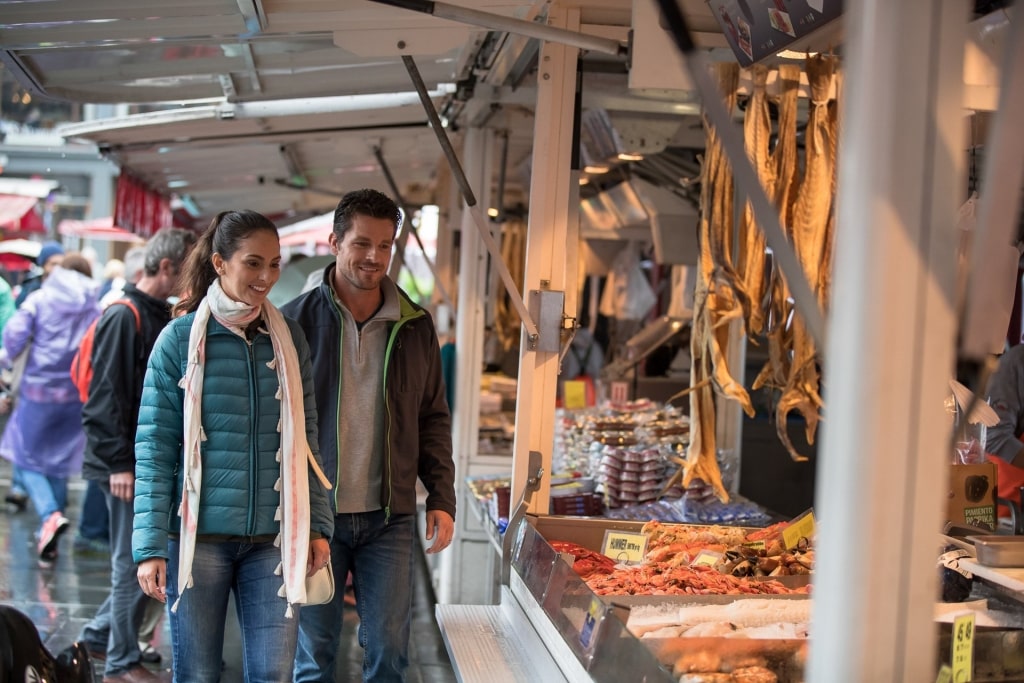
Bergen Fish Market
The ocean is only one side of the Norwegian larder. Farming the land of one of Europe’s most mountainous countries, of which only 3% is arable, has promoted a culinary inventiveness. Methods of preserving foods – smoking, air-drying, fermenting – bring a selection of uniquely Norwegian flavors to the palate. You might even have the chance to try an achingly tender reindeer steak, particularly if you’re visiting Norway’s wild north, the heartland of the nomadic Sámi people.
Ancient preparations, umami flavors, vivid history – you’ll wash it all down with one of the country’s renowned craft brews or a bracing glass of aquavit.
Here’s a selection of some of Norway’s most iconic dishes.
Brunost
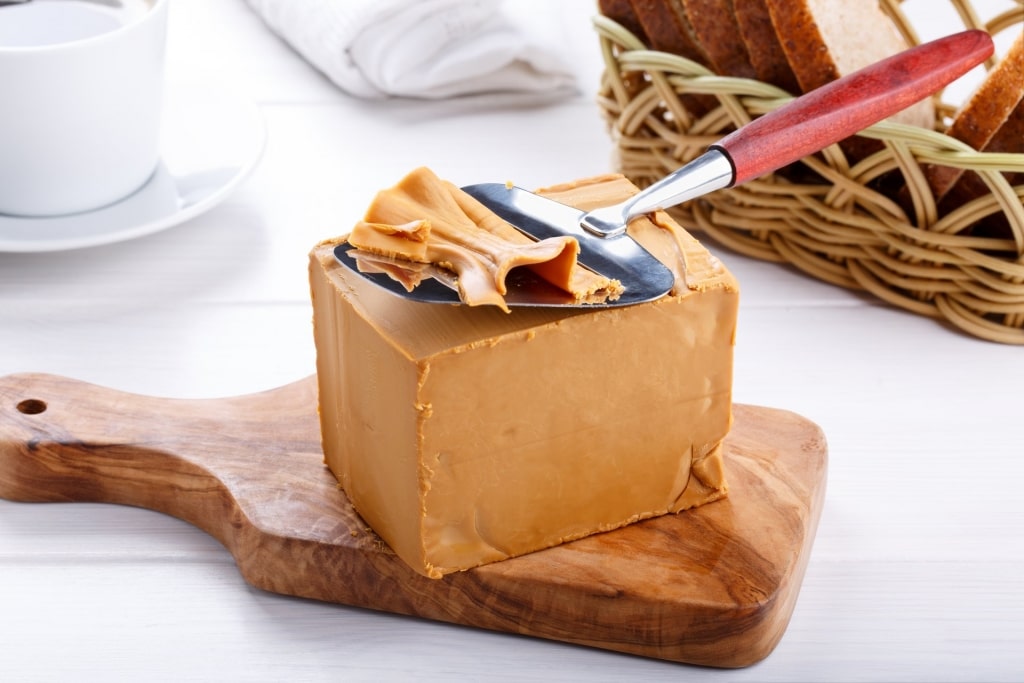
Brunost
Like many European countries, cheese is commonplace at breakfast, from southerly Oslo to Tromsø high in the Arctic Circle. Often you’ll find your eye drawn to the tan-brown cube rising from the heart of the table – this is brunost (brown cheese).
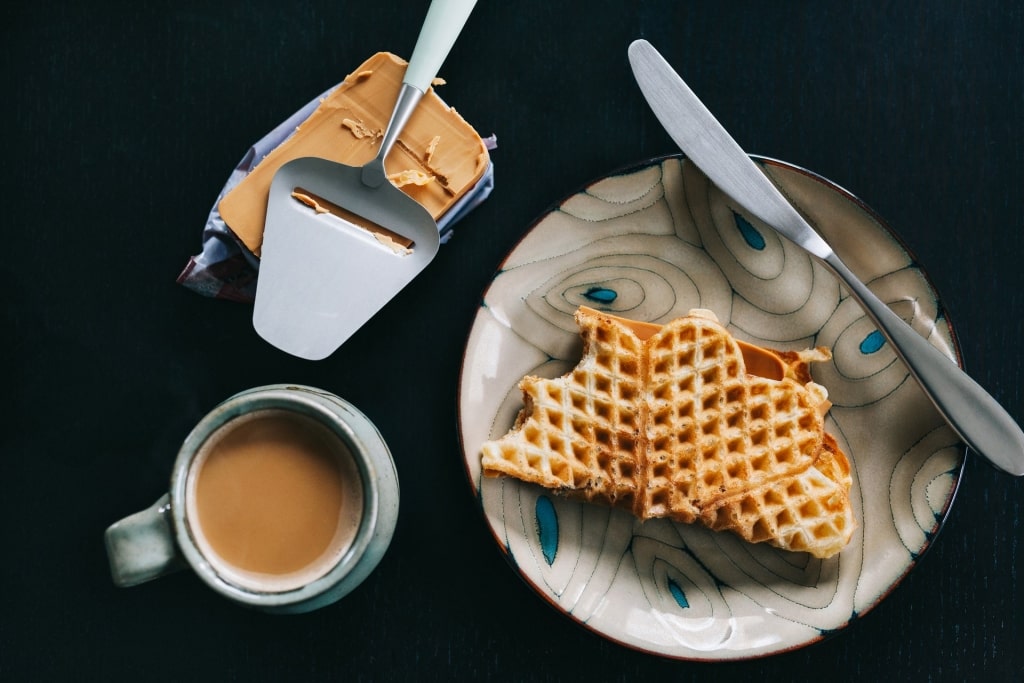
Waffles with brunost
This fudgy whey-based cheese product with a savory caramel flavor is beloved of Norwegians, whether for breakfast or for slathering onto heart-shaped waffles. The tell-tale tan derives from milk sugars caramelizing during the production process.

Jarlsberg
Brunost – alongside school-lunchbox staple, Jarlsberg – used to be widely viewed as the be-all of Norwegian cheese. Today, the situation is much different. A farmhouse cheesemaking renaissance has seen Norway celebrate two world champion wins within four years at the annual World Cheese Awards. Norwegian food is conquering the world.
Farms such as Herdalssetra Mountain Summer Farm in the stunning fjord of Geiranger often welcome visitors in to witness the cheesemaking process. And, of course, to try the cheese.
Cheeses to try while visiting Norway include:
- Kraftkar: a crumbly, creamy blue and World Champion in 2016
- Lagret Fanaost: six-month-aged gouda-style and 2018 World Champion
- Gamalost: strong Viking-era “old cheese”
- Pultost: a soured milk, spreadable cheese flavored with caraway seeds
Rokt Las
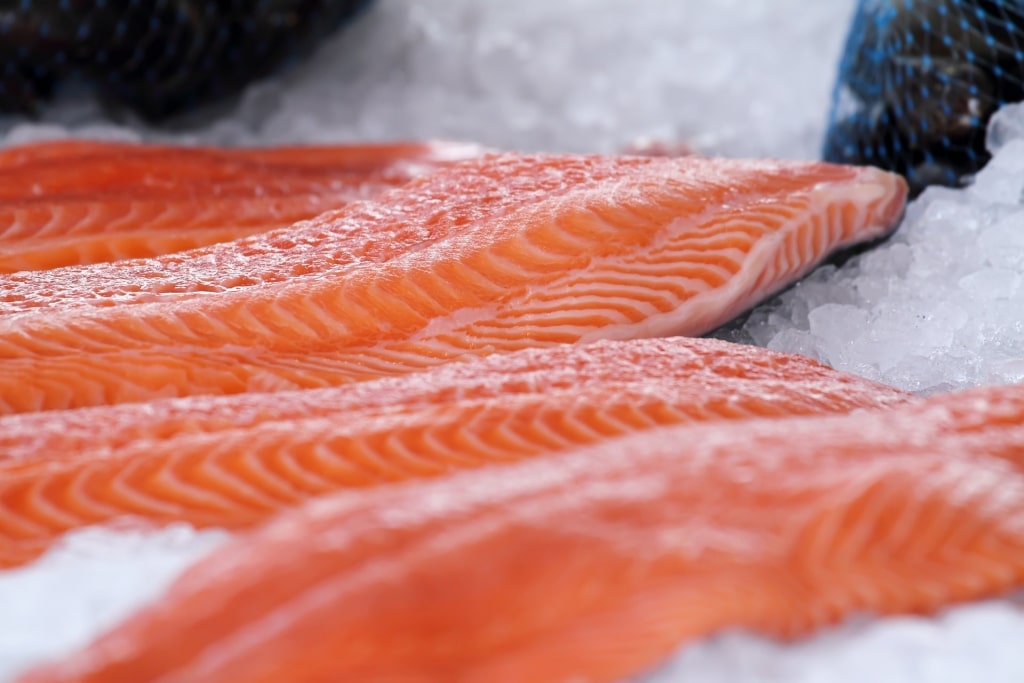
Norwegian salmon
Cruising a fjord and breathing in the crisp sea air, you’ll probably be too busy gazing at soaring cliffs or diving sea eagles to notice the wheels of salmon farms gilding the water’s surface.
Norway is one of the world’s largest exporters of farmed and wild salmon. Fortunately for locals and visitors, the best produce remains in-country. You’ll find its tender, peach-colored flesh served fresh in bustling fish markets near the docks, barbecued on the back of a sailboat, or served in the rarefied surrounds of fine-dining restaurants.

Rokt las
It’s likely you’re familiar with rokt las (smoked salmon). Smoking – along with other traditional hallmarks of Norwegian cuisine like fermentation and air drying – are low-tech, effective preservation techniques present since the sea breeze tugged at the Vikings’ braided beards.
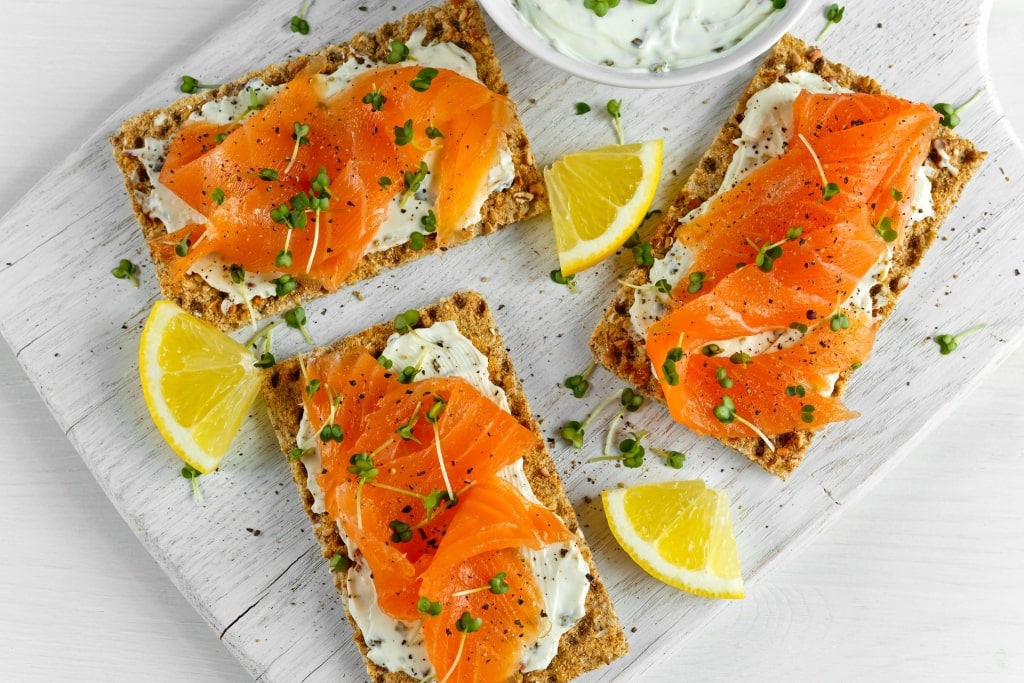
Gravlaks
Another method – dry curing – produces the popular gravlaks: smoked salmon dry-cured with a blend of dill, peppercorns, salt, and sugar. The Norwegians like it thinly sliced on open-faced sandwiches with their beloved sour cream or alongside stewed potatoes and a zingy mustard sauce.
Kjøttboller

Kjøttboller
Similar in concept to the Swedish meatball, the Norwegian kjøttboller differs primarily in its addition of ginger or nutmeg (or both).
Formerly the preserve of the upper classes – the only ones with access to meat grinders – this moreish 18th-century recipe is now a favored weekday dinner for the average Norwegian.
The kjøttbollers are simmered in thick gravy and served with mashed peas or creamed cabbage, often with a dash of sweet, sharp lingonberries to add a fresh note. A heartier equivalent is the kjøttkaker – slider-sized versions of the kjøttboller – perfect for restoring your stamina after a morning hike to a cliff-top viewpoint.
Sursild

Sursild
Who’d be a herring navigating the frigid waters off of Norway? If you’re not being targeted by crafty Norwegian fishermen, you’re being chased into narrow fjords by pods of equally crafty orca.
Sursild (pickled herring) is perhaps this in-demand fish’s most renowned guise when it comes to Norwegian food. The herring is salted before being submerged in a vinegar, onion, and spice pickling mix. Often served at breakfast, the sweet and sour tang of its pert flesh can be as energizing as an espresso.
If that’s too much fish, too early for you, it’s also a dream in lunch salads sprinkled with dill. Look out for herring slices in a variety of marinades that deliver an enticing new take on the mouth-watering umami punch of the classic mix.
Tørrfisk
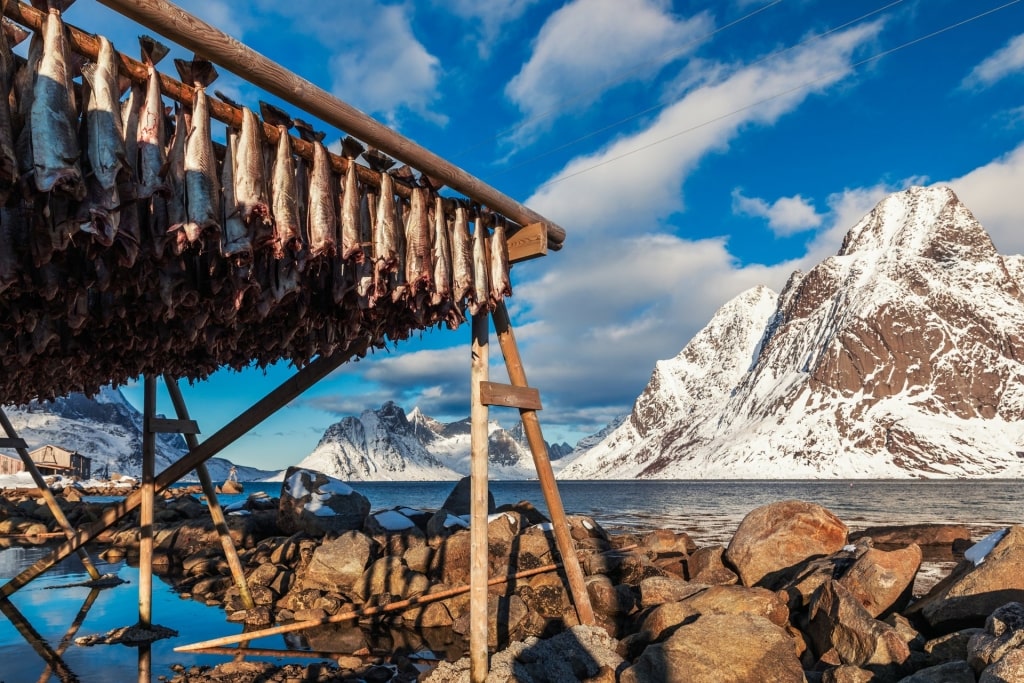
Tørrfisk in Lofoten Islands, Norway
Meaty Norwegian cod are renowned for their delicate flavor and flaky texture. So sought after are the migratory skrei (arctic cod), they act as the focus of the World Cod Fishing Championship near Norway’s Lofoten Islands. In restaurants like Fisketorget adjacent to the fish market in Stavanger, you can have your lunch made fresh from cod caught that morning, while you were sleeping in.
A nationally beloved take on cod is Norway’s tørrfisk (stockfish). You’ll frequently see the a-frame wooden racks (or ‘stocks’) of stockfish air-drying along the shore. After it’s matured and graded for quality, the mild-flavored, crunchy fish is sold in snack bags, as stockfish ice cream, or as the basis for the culturally important lutefisk (lye fish).
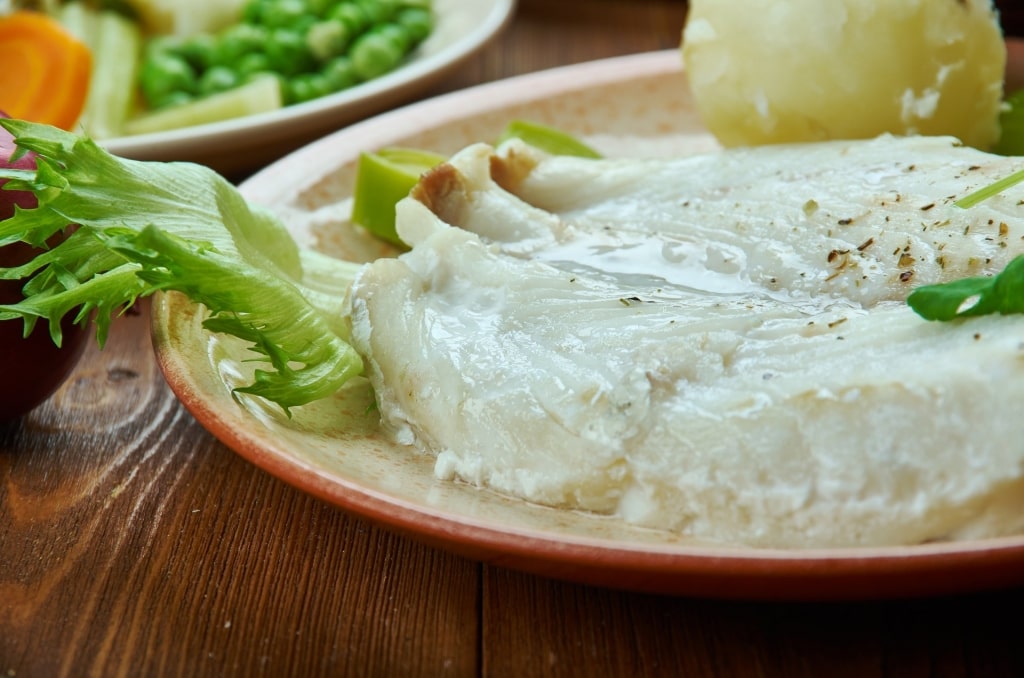
Lutefisk
A Christmas dinner stalwart, lutefisk – stockfish rehydrated in lye – was a favorite of the country’s medieval royalty. After the lye is flushed out, cooked lutefisk is mild in flavor and most notable for its springy texture. The dish is punched up with a peppery white sauce or sweetened with golden syrup.
Rakfisk
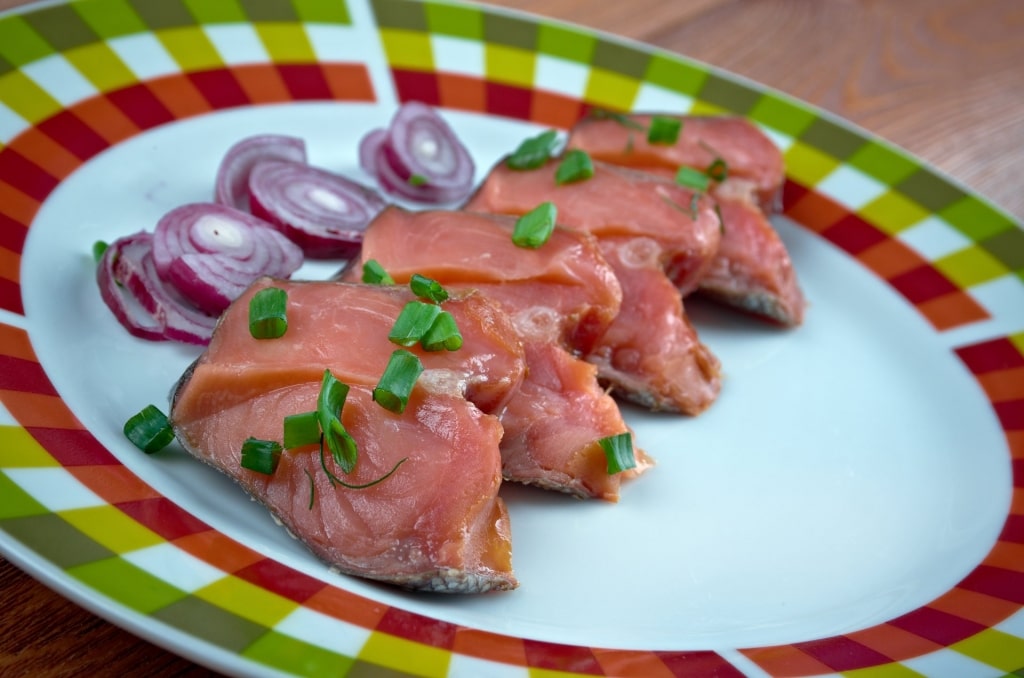
Rakfisk
An icon amid Norwegian gourmets, Rakfisk is fermented freshwater trout. The salted fillets are stacked and weighted down in barrels, covered with spruce branches, and sealed up for several months.
When the rakfisk is awakened from its briny slumber, it’s celebrated in countrywide festivals in the fall. You’ll find the locals enjoying it spread on flatbreads with sour cream to balance the salt, and with transparent slices of red onion to compliment rakfisk’s surprisingly gentle piquancy. The dish is notoriously pungent, and Norwegians favor a glass (or several) of aquavit to balance the nose.
Multer
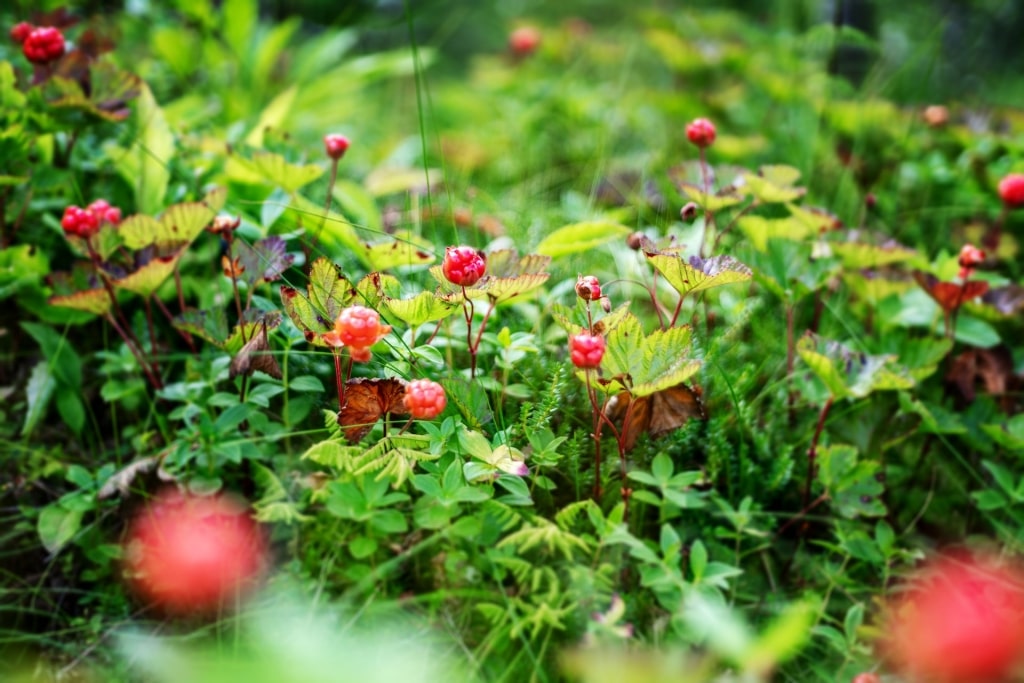
Multer
Berries enjoy an exalted place in Scandinavian cuisine, since much fruit is ruled out by the brevity of the summer. Tyttebӕr (lingonberries or cowberries) have an acidity and flavor reminiscent of the cranberry. You’ll often find them, scarlet and bright, piled or pureed alongside tender cuts of reindeer or slow-cooked lamb.
But it’s the nutrient-packed multer – or cloudberry – that’s a true Norwegian food treasure. This large, apricot-colored berry – a slightly sharper relative of the raspberry – grows on low-lying plants in boggy marshland. Difficult to farm, locations of this “Arctic gold” are guarded in Norway with the same zeal as truffle patches in Italy.
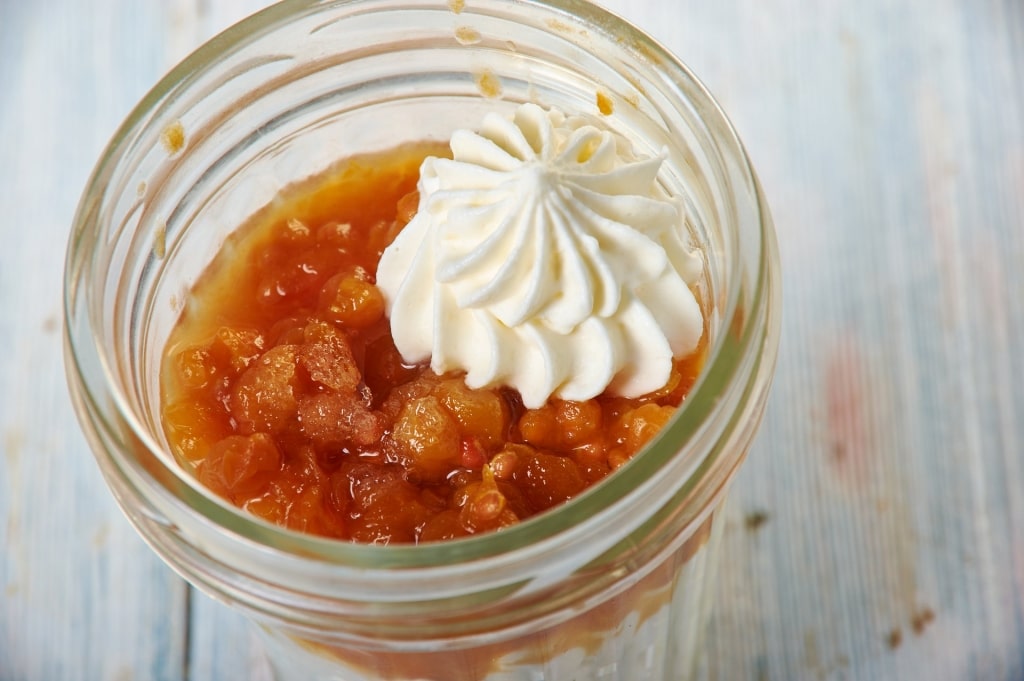
Multekrem
While they make a delicious gold and ruby jam, cloudberries find their apotheosis in multekrem. This heavenly Christmastime dessert has the vivid cloudberries folded into a cumulus of vanilla-infused whipped cream.
Fårikål
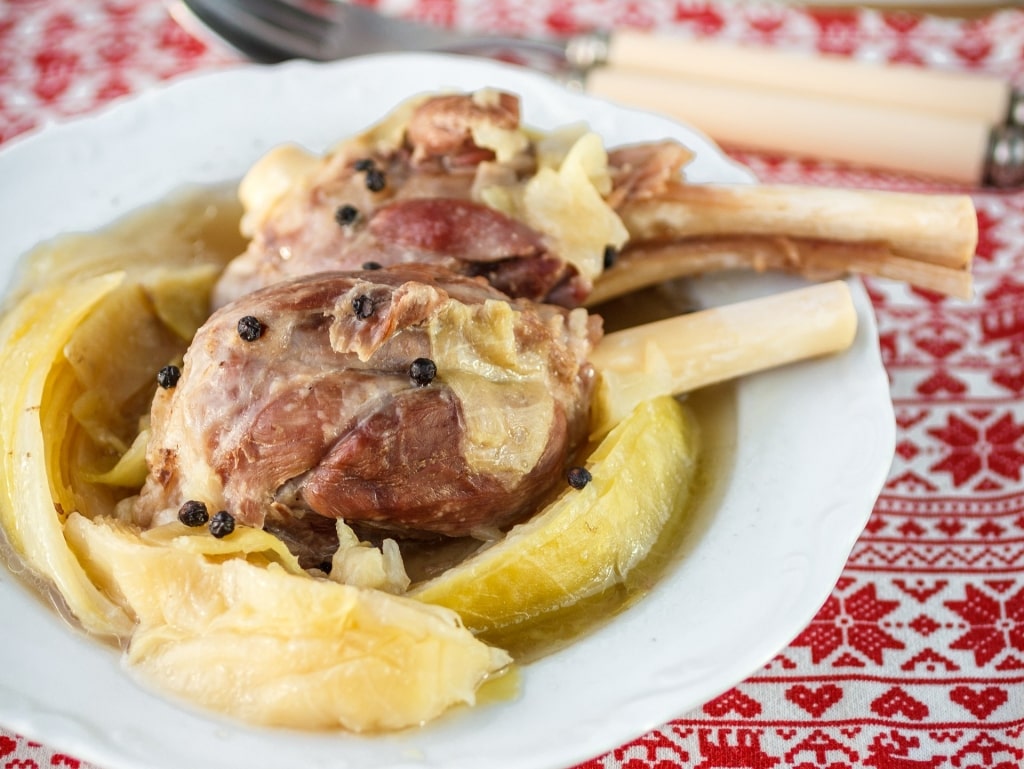
Fårikål
Norway’s national dish, Fårikål, is a celebration of a key ingredient in Norwegian food—its free-range sheep. The herds rove the land nibbling whatever herbs and plants they prefer, and that nutritional variance imbues flavor and succulence into their meat.
The recipe for Fårikål, therefore, keeps it simple: slow-cooked, on-the-bone mutton and cabbage stew liberally seasoned with black peppercorns and served with boiled potatoes and a whip-crack of acidic lingonberry sauce.
A tradition for when the temperatures begin to creep downward, Norwegians celebrate Fårikål Feast Day on the last Thursday of September. While it’s prevalent in western parts of Norway, you can find top-notch Fårikål served in Oslo’s restaurants that are dedicated to classic Norwegian cuisine.
Lefse
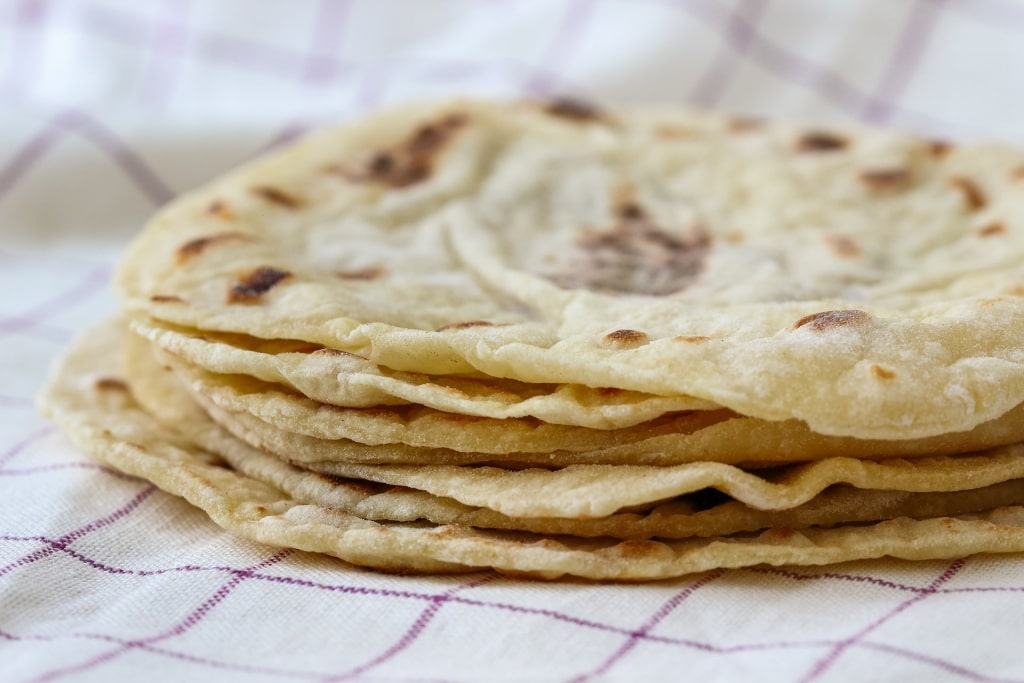
Lefse
The traditional flatbread of Norway is a pancake-like morsel comprising flour, potatoes, butter, and cream. While such a scant selection of ingredients suggests a single recipe would be easily agreed upon, it’s fair to say that lefse on one side of a fjord will be made differently to lefse on the other side. And both sides will insist that they make the true lefse.
As with most flatbreads, lefse is a neutral base waiting to be colored in by other ingredients. Go sweet with cinnamon, sugar, and lingonberry jam, or savory wrapped around smoked salmon and sour cream.
Visit in the winter, and you’re sure to see a cross-country skier slide by. It’s likely their pack includes a Tupperware of buttered flatbreads to snack on – the Norwegian equivalent of trail mix.
Pinnekjøtt
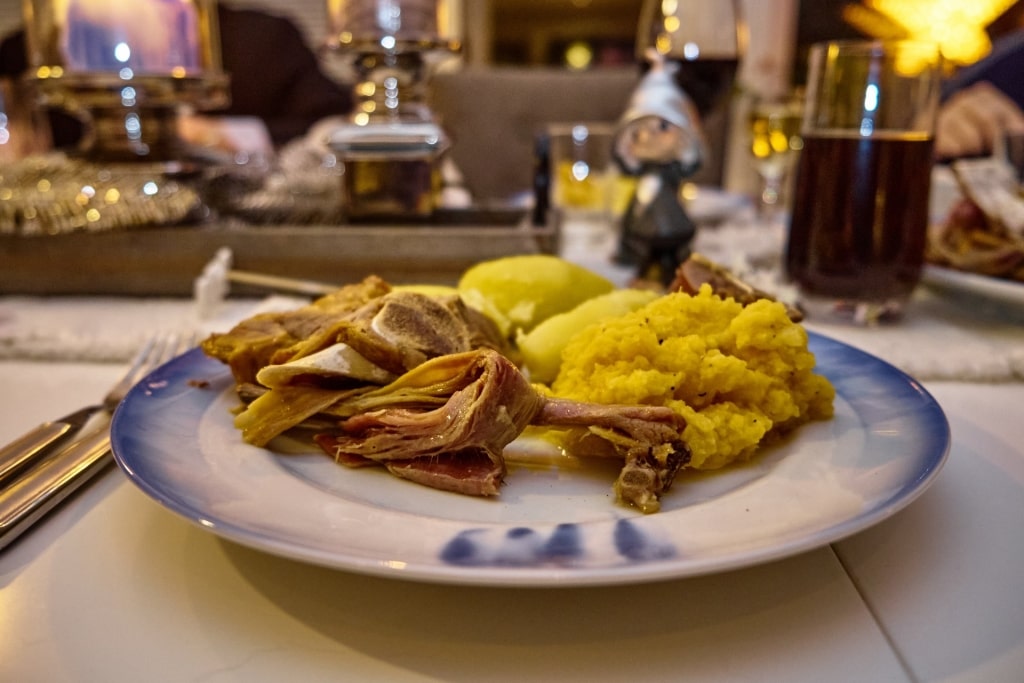
Pinnekjøtt
Pinnekjøtt translates as “stick meat”. While the name might lead you to assume that this is Norway’s answer to the kebab, it’s in fact a dish of salt-cured rack of lamb that is air-dried before being steamed over birch twigs (this last part supplies the name).
A Christmas Eve favorite – tussling with ribbe (roasted pork belly) as the darling of seasonal Norwegian food – rich, salty pinnekjøtt is balanced by a side of sweet mashed swede. Add lutefisk, sausages and roast ham, all washed down with a hot, herbal Gløgg (Norway’s answer to Gluhwein), for a truly seasonal plateful.
Smalahove
Cameras at the ready: Smalahove is a sheep’s head served on a plate. This rustic delicacy is a nod to the historic necessity of nose-to-tail eating, particularly in the more rugged west of the country. This is Norwegian cuisine at its most pragmatic.
Smoked and salted before being boiled for several hours, Smalahove is historically washed down with a homebrew (for the flavor pairing, although it might also help with courage). Try a domestic craft brew like Aegir’s hoppy, fruity – and 9.0% – Ratatosk Double IPA.
The choicest cuts are reputedly around the eyes and ears. It’s not so common to find the brain intact nowadays, cooked within the skull, although if you’re served with a spoon, be ready.
Finnbiff

Finnbiff
Northern Norway is a rugged, snow-covered wilderness that reaches into the Arctic Circle. It’s home to bears, wolves, and the indigenous Sami reindeer herders. Reindeer is prevalent across menus in the north, although the lean, mildly gamey meat tends to be found in restaurants throughout Norway.
While the Sami themselves cook with all parts of the reindeer, including the heart and the blood that it pumps, it’s most commonly found in a hearty stew called bidos or sauteed as finnbiff. Cooked in butter or reindeer fat until meltingly tender, finnbiff arrives at the table immersed in a creamy gravy with a dollop of lingonberries that have been mashed with sugar.
During autumn, the start of the hunting season floods menus countrywide with a mouth-watering variety of game. Norwegians have learned how to get the best out of these meats, so be sure to study menus for medallions of moose, juicy venison, or tender grouse.
Kumla
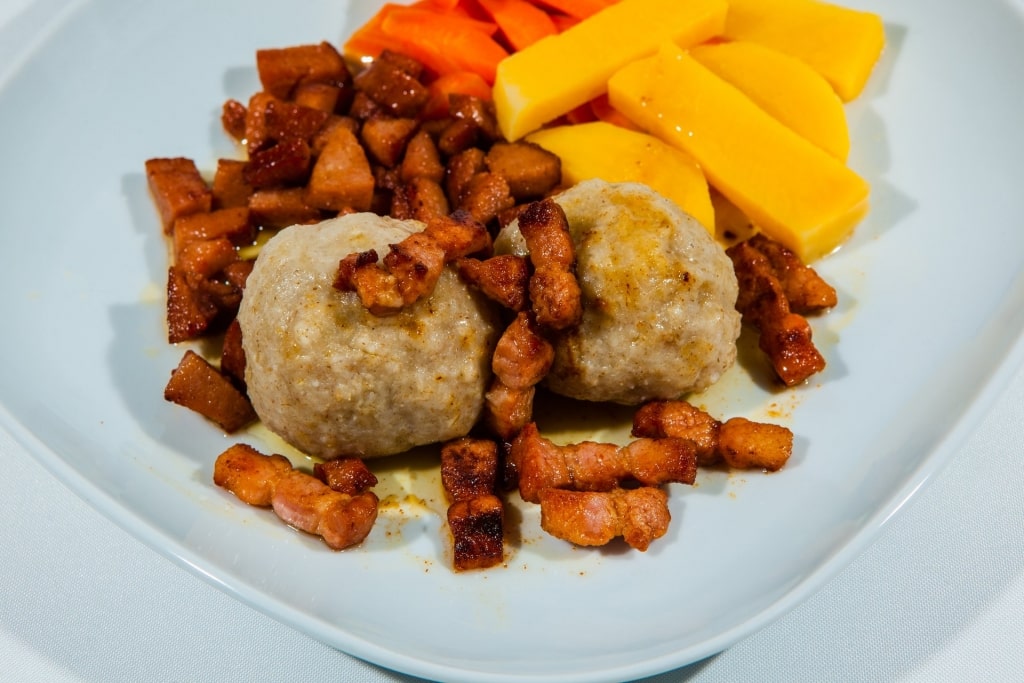
Kumla
Derived from the same restorative, high-calorie philosophy of cuisine enjoyed in alpine ski chalets, kumla is an umami-ish potato dumpling meal designed to maintain the energy levels of toiling farmhands.
The recipe, often a treasured hand-me-down through the generations, typically involves a mashed potato and flour dumpling simmered for over an hour in a stock made from fatty cuts of mutton or pork. A brown butter sauce – or occasionally melted brunost – is drizzled over the top.
It’s highly customizable – for example, some come with pieces of fried bacon pushed into the dumpling’s center. Particularly successful versions, such as Flåm’s raspeballer equivalent (a salt and fat hallelujah when paired with pinnekjøtt and an IPA from renowned local brewery, Aegir), can become well known. Look out for kumla on menus countrywide as a mid-week special.
Krumkake

Krumkake
Norway’s krumkake (bent cake) is the daintiest, prettiest waffle cone you’re ever likely to hold.
Pressed in a two-sided griddle that imprints the wafer-thin cone with hearts or flowers, the krumkake is then molded around a wooden spindle before being filled with whipped cream. Available pretty much anywhere from the watery south to the frozen north, you’ll find the best somewhere like Stavanger’s historic Vaaland Dampbakeri & Conditori which has been perfecting these delicious treats for over a century.
Norwegians are also passionate about straight-up waffles. These omnipresent treats come heart-shaped, crisp, and chewy, glistening with strawberry jam and cream.
Aquavit
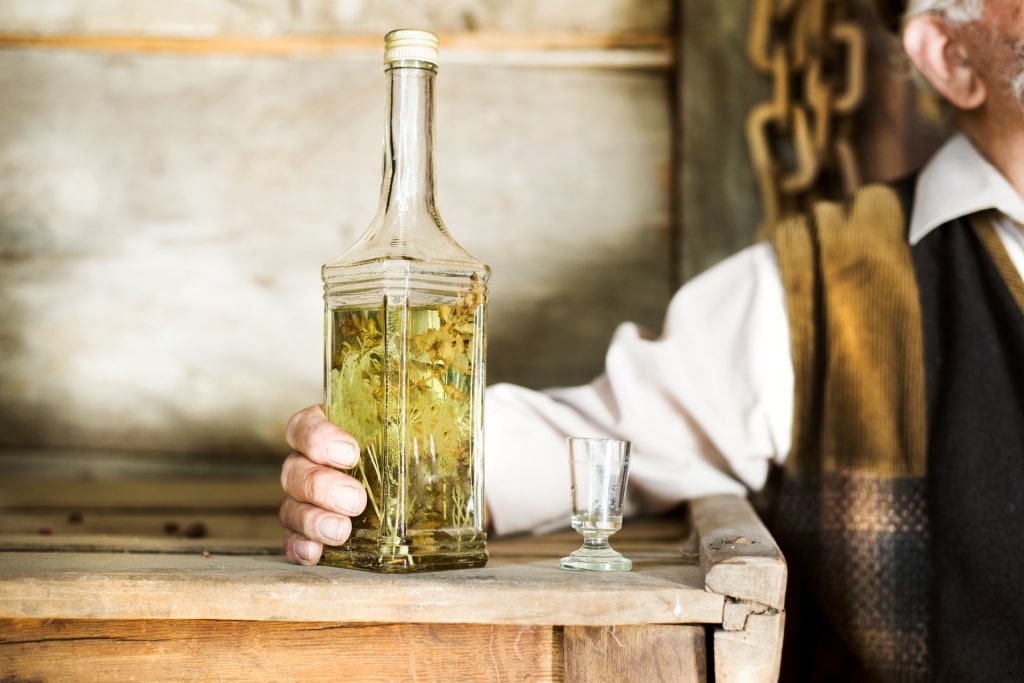
Aquavit
Norway’s National Drink, aquavit (water of life) can be most concisely described as an oak-aged vodka infused with botanicals. Dill or carraway are essential ingredients, with further spices and herbs mingled in as required by regional and culinary preferences.
A cornerstone of Norwegian gastronomy since the 15th century, aquavit remains a key element of any spirited Scandinavian gathering. Served in elegant fluted glasses, the clear, cold drink is a knockout paired with rokt las; the dry, often citric flavor cutting through the smoky richness. Skol!
Lutefisk
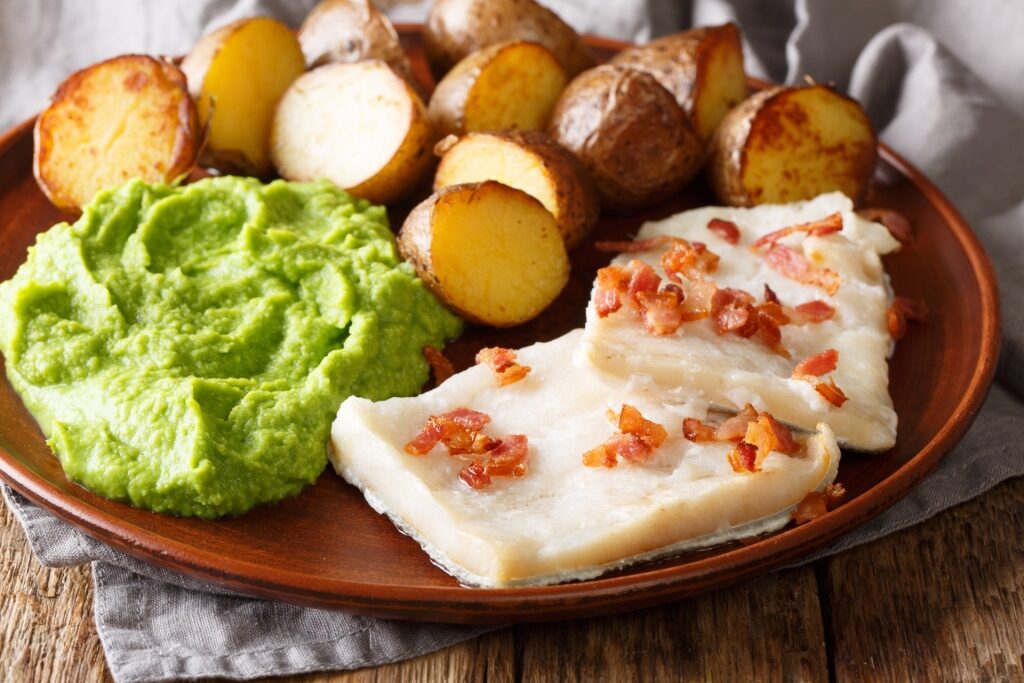
Lutefisk
A recipe that some believe was cooked up by Norway’s Viking forebears, this preparation of whitefish is an icon of Norwegian food. With lutefisk, dried cod is usually rehydrated with lye and water in a process that takes about a week.
The results are interesting, to say the least. The fish swells—an aspect that sometimes helps food last longer during lean months—and the lye raises the alkalinity levels, making the fish less susceptible to bacterial degradation.
The result on the plate? Fish with a unique texture that’s somewhere between gelatinous and springy. Fortunately for lutefisk newbies, the flavor follows suit and is about as elusive as the lutefisk mouthfeel.
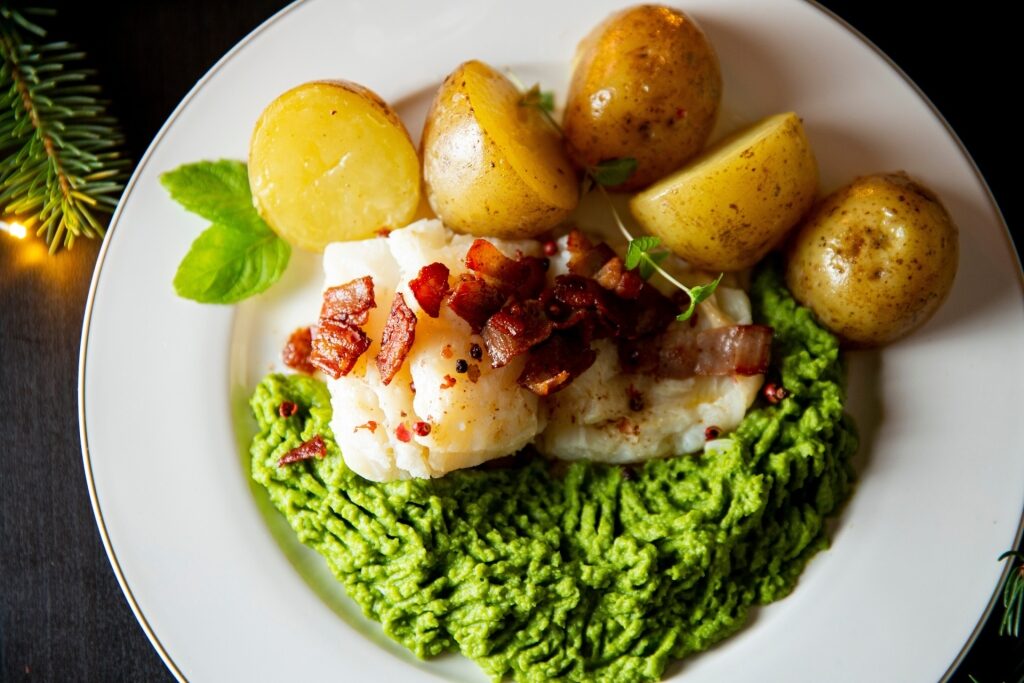
Lutefisk
It’s most commonly enjoyed at Christmas, served alongside strong flavors like mustard and bacon for contrast, and a glass of good aquavit to wash it down. If you order lutefisk in a more modern restaurant, you might find it’s been pan-fried—taking its signature texture into firmer, more broadly palatable territory—and served with a peppery white sauce.
Rømmegrøt

Rømmegrøt
Rømmegrøt is the Norwegians’ signature take on oatmeal. A dish with roots in Norway food’s medieval era, it’s the addition of the sour cream that makes rømmegrøt such a delicious dish.
The cream is boiled before being added to the cooked oats, and it supplies a distinctive, pleasant tang beneath the sweet haze of sugar and cinnamon—and sometimes melted butter—added on top.
Rømmegrøt, with its connections to ancient fertility rituals, can often be found in bowls steaming gently at Norwegian weddings. To start your day with a complete Norwegian flavor bomb, try it with a glass of tart lingonberry juice.
Gravlaks
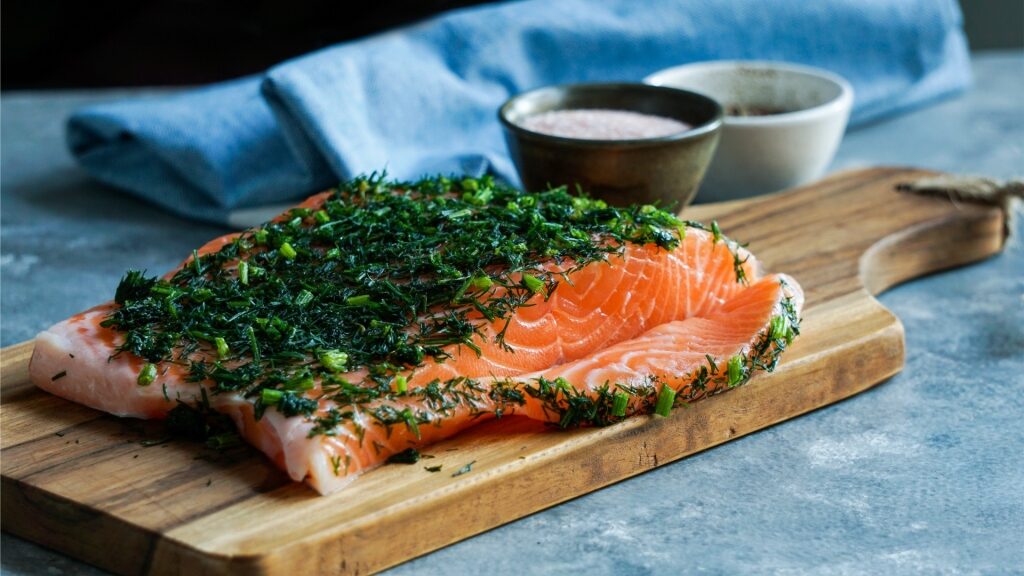
Gravlaks
One of Norway’s most popular exports, gravlaks represents another of the country’s celebrated medieval preparations that has endured to this day.
If you eat fish, it’s likely you’ve already tried it, whether as part of a buffet selection or laid out as the centerpiece at Christmas, a favorite time for it to be eaten in Norway. As you might expect, this isn’t one of those ancient dishes that require a stern glass of high-proof alcohol as an accompaniment.
The original version might have been, however. Gravlaks translates as “buried salmon,” and its medieval preparation involved wrapping it in birch bark and burying it in wet sand to help preserve the fish for longer. Fermentation and a pungent flavor were brought on, but no rot.

Gravlaks
By the 18th century, with salt more accessible, the Norwegians clearly agreed among themselves that one punchy fish recipe—rakfisk—was enough, and evolved gravlaks into something you could introduce to your mother. Today, it’s cured with sugar, salt, and dill, and served with malty rye bread and mustard-dill sauce.
Spekemat
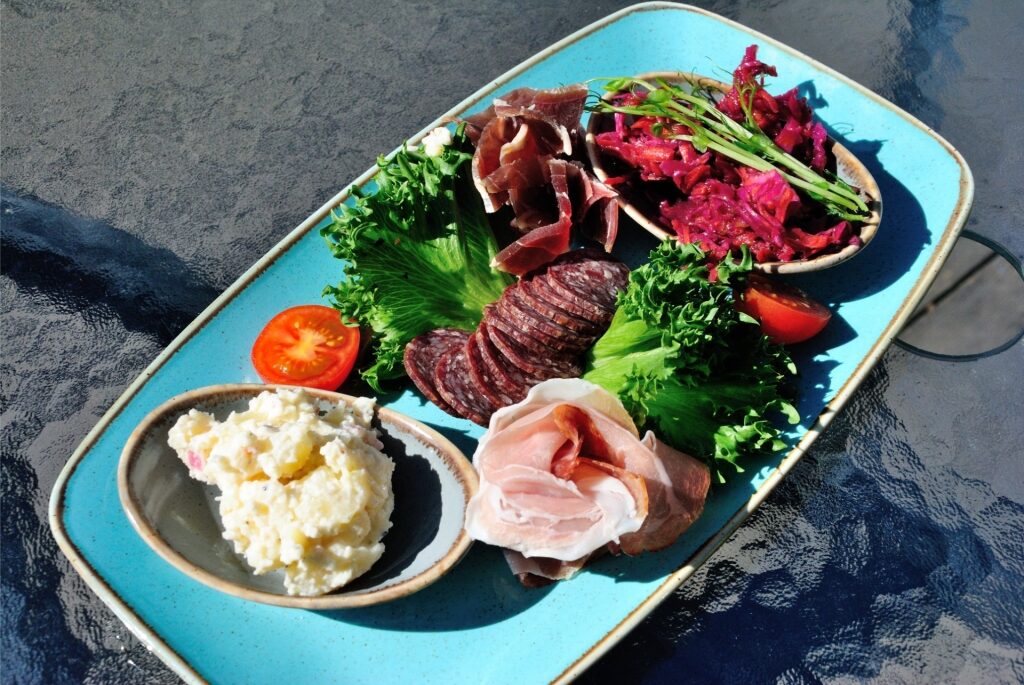
Spekemat
The Norwegian charcuterie platter, spekemat, is a selection of cured meats sliced and arranged on platters with a selection of pickles, mustards, cheeses, and flatbreads to accompany.
Despite the hegemony of the French term, charcuterie is something of a worldwide phenomenon, and unquestionably a passion of the Vikings. With the short, tepid summers and frostbitten winters of Norway, the forebears of modern Norwegians were experts in preservation.
Techniques such as salting and smoking helped keep meat from rotting, and in turn brought it to a state of savory deliciousness. On your spekemat, look out in particular for fenalår—ribbons of ruby red air-dried lamb—as well as marbled slices of the country’s beloved Voss mutton sausage.
Sodd
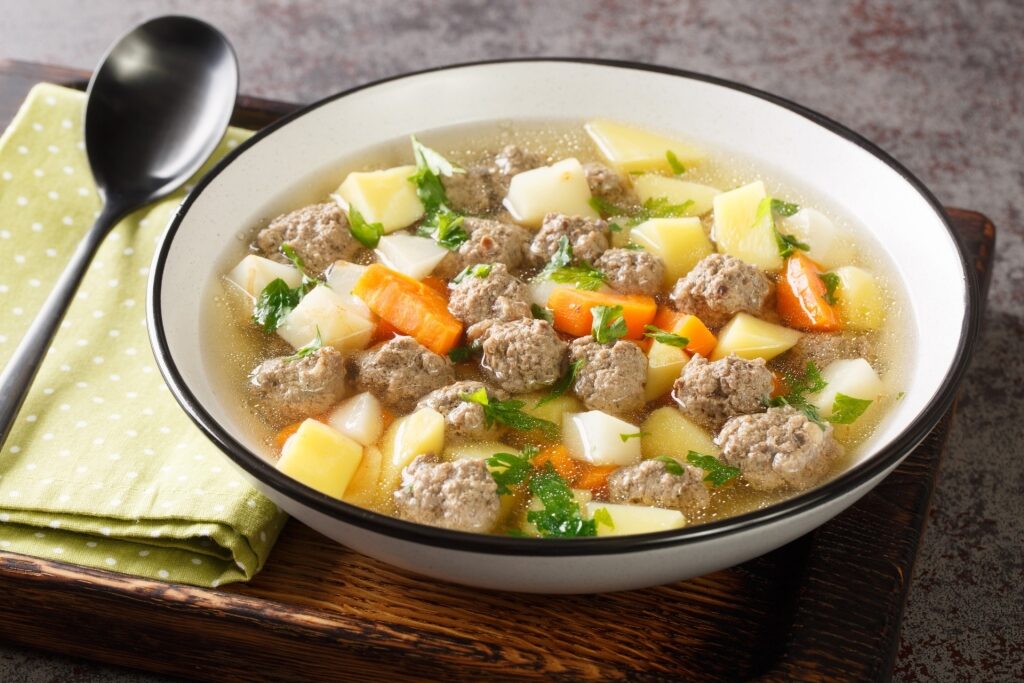
Sodd
Among the many centuries-old dishes that comprise traditional Norwegian food, sodd offers a real sense of ritual.
It’s a simple enough dish. First, prepare a bowlful of boiled potatoes and carrots. A beef or lamb broth, bobbing with cubed mutton and seasoned with ginger and nutmeg, is then poured over the vegetables at the table.

Sodd
This was once a staple of medieval feasts and you can find mouthwatering mentions of aromatic sodd in Norse sagas. Today, it’s most popular in the central region of Trøndelag and the city of Trondheim, where this dish’s deep traditional associations see it appear regularly at confirmations and nuptials.
Raspeballer
From a distance, raspeballer may appear to be a dollop of mashed potato on your plate, but peer closer and you’ll see it’s mashed potato, Norwegian food-style.
There are striking similarities between the raspeballer recipe and that of German potato dumplings. Although with the number of different names that this popular side enjoys—sometimes “klubb,” sometimes “kompe”—it demonstrates that perhaps this filling, delicious, and, most importantly, rather simple dish sprang up in multiple locations.
Grated potato mixed with salt, flour, and water, the raspeballer mix is boiled in a savory broth until it’s served up as a chunky side. Keep your eye peeled for menus serving raspeballer with dott, as this indicates that crisped up bacon pieces will be scattered over the dish.
Thursday is widely considered the day of raspeballer or “komle-torsdag”, as it’s known. While it’d be more exotic to say this is because it’s Thor’s favorite food—Thursday is derived from “Thor’s Day”—it’s actually the legacy of a sales trick that restaurants employed to lure evening shoppers in for some cheap and delicious raspeballer.
Skillingsboller

Skillingsboller
One of the stand-out pastries of the Norwegian bakery shelf, skillingsboller is essentially Norway’s cinnamon bun. It traveled from Germany to Bergen in the medieval era, carried amid the flurry of trade unleashed by the highly successful Hanseatic League.
Once this doughy roll of cinnamon and sugar was tasted by the Norwegians, it was quickly copied and absorbed into Norway’s culinary pantheon. Its name derives from what it cost at the time: a solitary Norwegian skilling, very well spent.
With modern bakers prone to experimentation, you’ll find new variants of skillingsboller available with aromatic variations such as cardamom dough or apple-lined interiors. These are diverting, but pale in comparison to the real thing. Skillingsboller are often enjoyed during the Scandinavian ritual of fika—a kind of enhanced coffee break with friends.
Elgstek

Elgstek
Elks are known as the “King of the Forest” in Norway, and their majestic spreading antlers are a common sight in the Scandinavian wilderness, as well as on the walls of more rural restaurants.
In fact, so popular is elk hunting in Norway that there’s even a dog for that—the Elkhound, which is also the country’s national canine.
Elk on the menu is usually served as a slow-roasted plateful, the lean meat often marinated in a red wine sauce flavored with juniper and garlic. Due to hunting regulations, there’s usually more elgstek to go around in fall and winter. Served with lingonberry sauce, gravy, and steamed vegetables, it’s the perfect antidote to a chill nor’easterly off the fjord.
Reinsdyrpølse
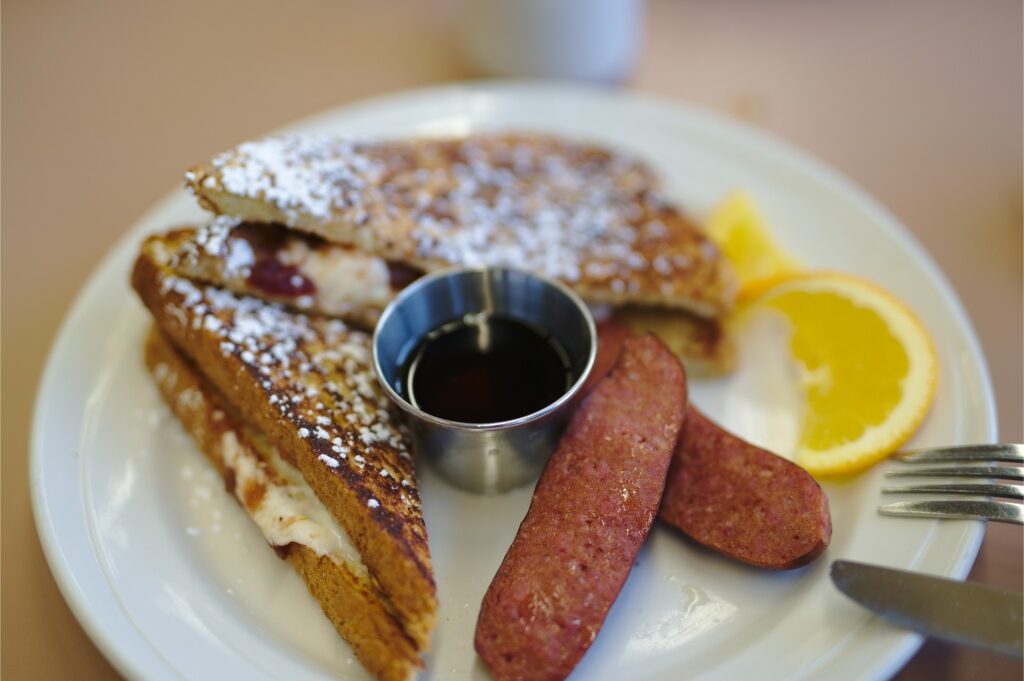
Reindeer meat
Across northern Norway, high in the Arctic Circle, the Sami reindeer herders have followed their traditional way of life for thousands of years. Today, they’re supplying Norway with its top-grade reindeer meat, while integrating tech such as GPS to track their free-roaming herds.
Like elgstek, reindeer is a lean meat that offers a healthy alternative to beef. In its sausage form, it’s typically smoked or air-dried before being ground up and mixed with spices. The result is rich and gamey, and comes sliced as part of a spekemat, or grilled. Lingonberry chutney cuts nicely through the sausage’s richness.
Gammelost
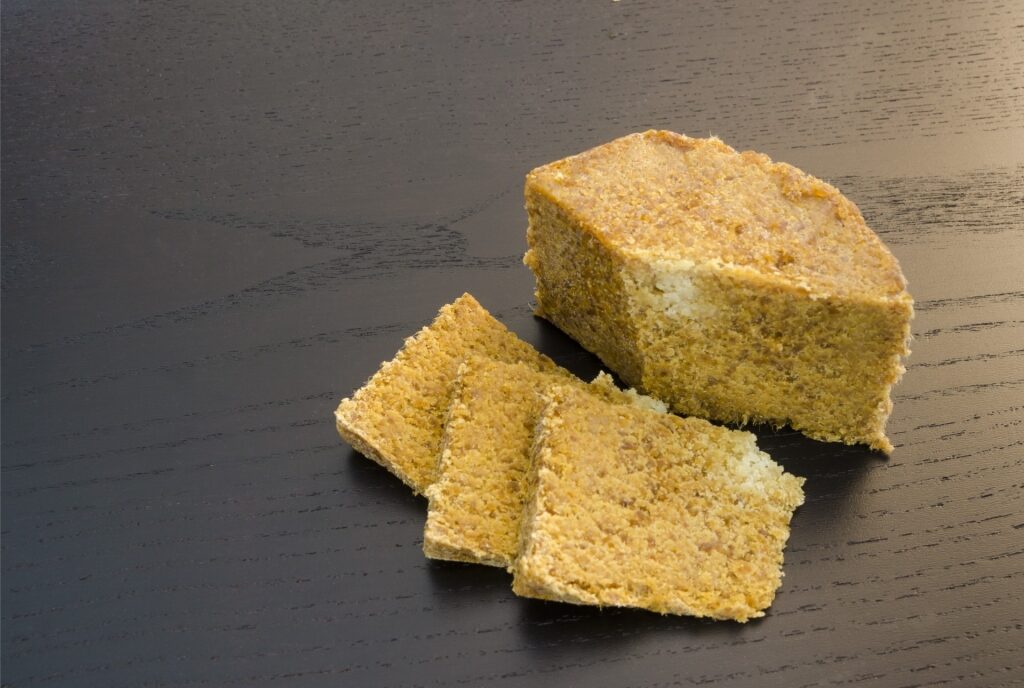
Gammelost
A crumbly cornerstone of Norwegian food, gammelost is one of the country’s most famous cheeses.
A product of medieval dairies, gammelost today hews very closely to the original centuries-old recipe. It’s traditionally made with skimmed milk, as the rich cream would traditionally have been skimmed off to turn into butter.
While this stout round is typically aged for about a month, its production process ensures that it, like the dried fish or crispy flatbreads of the Vikings, could be stored for a good period of time without becoming unapproachable.

Gammelost
Known for its punchy aroma and sharp flavor, this cheese is usually paired with slices of dark rye and sour cream to help balance its robust character. Relatively rare these days, it can be found in specialist cheese shops or in high-end restaurants.
Read: Beautiful Places to Visit in Norway
Brun Lapskaus
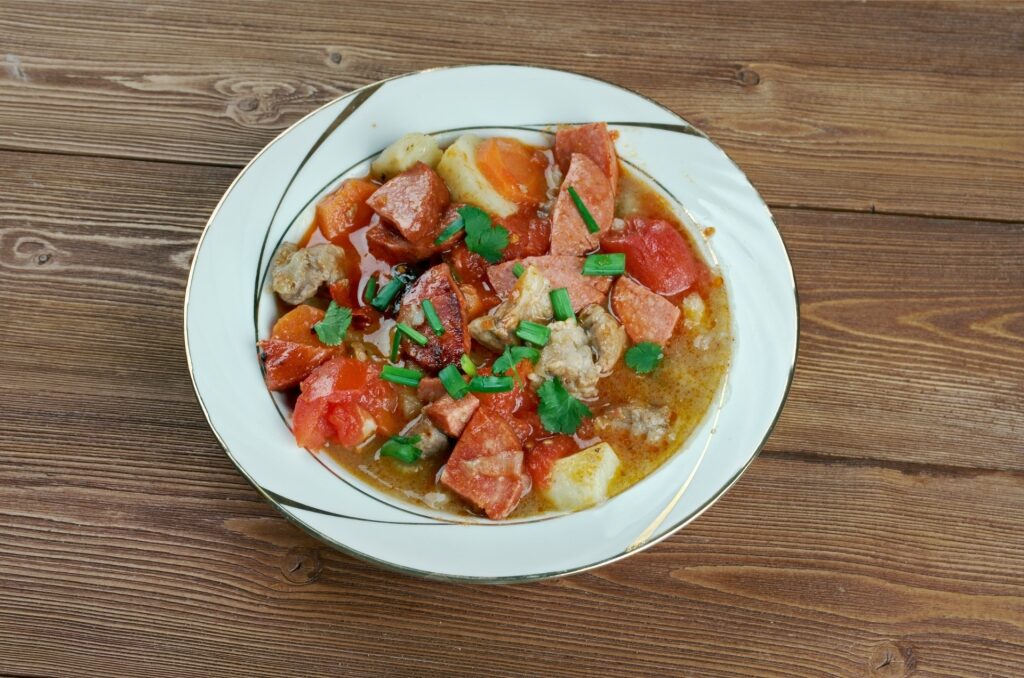
Brun lapskaus
There’s often little music in the names bestowed upon Norwegian food recipes, and brun lapskaus, or brown stew certainly confirms this.
Despite its uninspiring name, this stew enjoys widespread popularity in Norway. The rich aroma of simmering brun lapskaus wafts through fjordside kitchens and big city restaurants from Tromso to Bergen.
This stew, derived from lobscouse—a dish that originated in the British port city of Liverpool—simply throws browned chuck steak in a pot with chopped rutabaga, potatoes, carrots, and leeks. All is immersed in a deliciously brown and beefy broth, and simmered until the meat is melt-in-your-mouth tender. Norway’s crispy flatbrød is a common accompaniment.
Pølse Med Lompe

Pølse med lompe
The wildly popular pølse med lompe is a wonderful example of how Norwegians will adopt an apparently bulletproof recipe and give it their own spin.
Pølse is the Norwegian word for a sausage, but the locals will generally understand that you mean a hot dog. The country has been sausage-mad ever since the first horny-helmeted ancestor ground up some meat and stuffed it in intestine skin. When hot dogs arrived from the USA in the mid-20th century, they were swiftly embraced and devoured.
The Norwegian dog—a shiny tube comprising pork or chicken—is served boiled or grilled in the manner of all hot dogs everywhere. But the Norwegian twist arrives with the lompe—a soft potato flatbread that enrobes the wiener. The toppings can be as common as ketchup and mustard, or as Norwegian as shrimp salad.
FAQs
Is Norway a good food destination?
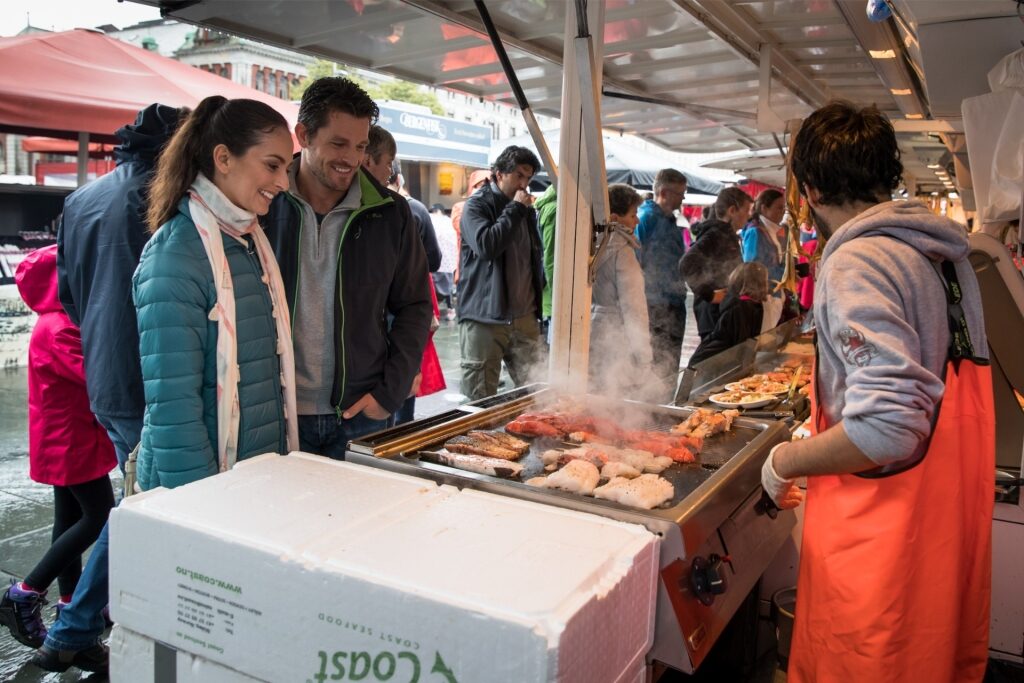
Bergen Fish Market
Absolutely. Travelers seeking a unique cuisine that represents authenticity, seasonality, and regional storytelling will be delighted with Norwegian menus. A hard history set in the country’s spectacular, if often hostile, landscape has evolved a food culture centered around preservation and resourcefulness.
From roast elk to lutefisk, the narrative of Norwegian food feels more present on the plate than the cuisine of many other countries.
What dish is Norway most famous for?

Gravlaks
Internationally, gravlaks—cured salmon with dill—is perhaps the most iconic dish Norway is known for. It’s elegant and delicious, both at home during a casual party and at pride-of-place during a Christmas get-together.
Of course, there’s also Norwegian food’s niche dishes, such as rakfisk—fermented trout—that are whispered about among visitors to the country as the ultimate test of the taste buds. A dish that delivers a similar “jump scare” is smalahove, or a boiled sheep’s head.
What time does dinner typically start in Norway?

Fårikål
Dinner usually begins between 5 p.m. and 6:30 p.m., earlier than in many other European countries. This reflects both practical rhythms—many Norwegians finish work by 4 p.m.—and cultural habits shaped by long winters and early sunsets.
In rural areas, the evening meal is often the heartiest of the day, featuring warm stews like brun lapskaus or roasted game. Restaurants tend to follow this schedule, with kitchens closing earlier than in southern Europe.
Are there any Norwegian food customs I should know about?

Restaurant in Norway
The etiquette of Norwegian food culture will be easy to navigate for anyone familiar with general Western norms.
Norwegians eat a lot of bread, especially with the pålegg, or open-faced sandwich, which is a common lunch item, or amid their pastry-loaded coffee breaks. Whether during a fika or while having dinner, relaxed conversation is something that the Norwegians value. Expect to linger over dinner, rather than bolting your delicious elgstek.
Finally, be sure to slip into the local rhythms when you can. Thursday welcomes komle-torsdag—“Raspeball Thursday”—where many restaurants serve raspeballer as the dish of the day.
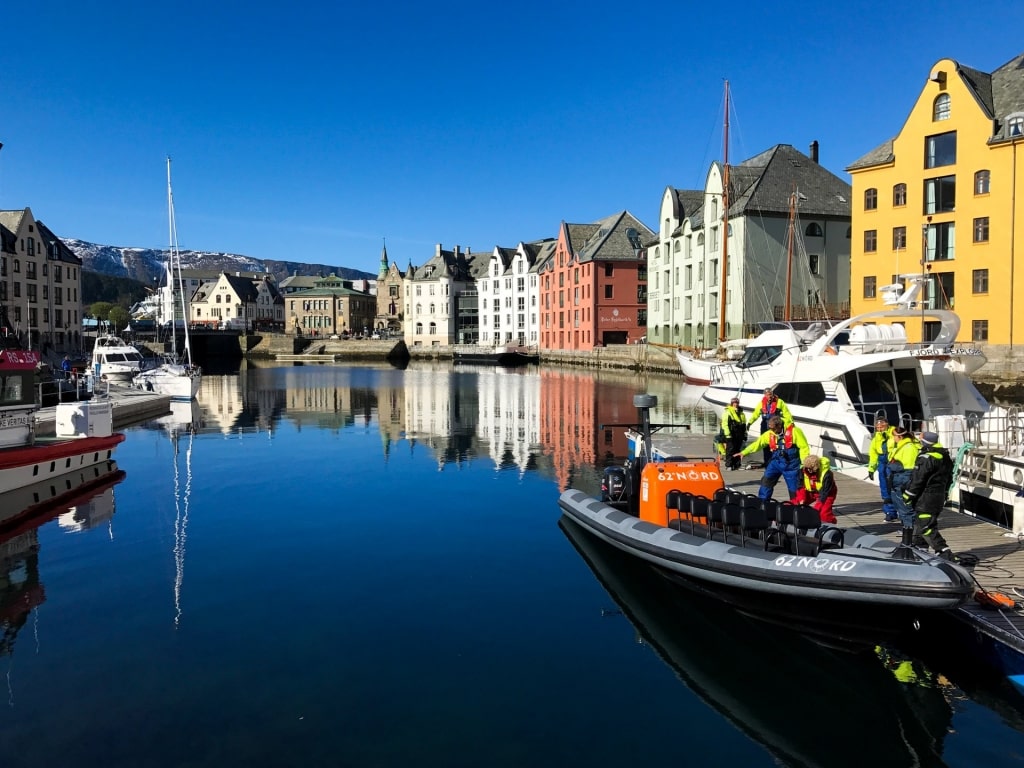
Alesund
Browse our itineraries online and experience all of these delicious dishes and more on a cruise to Norway’s astonishing fjords.


